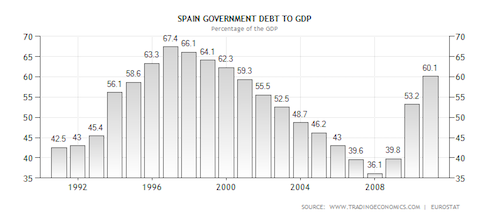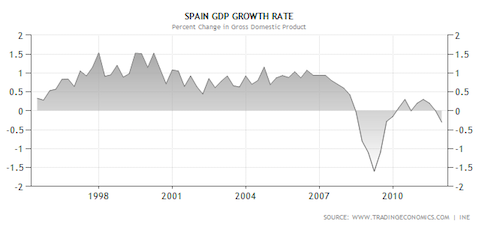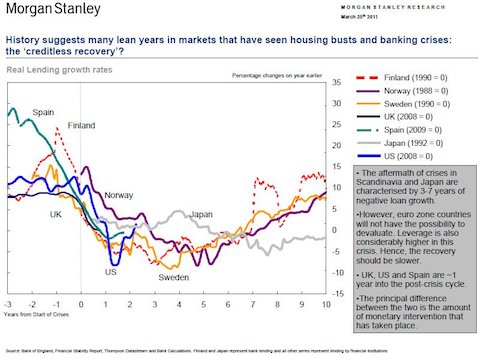So I return after the Easter break to find Europe in much the same shape as when I last saw it, with one minor difference. Spain is no longer an unrecognised risk, but a known issue:
Spanish bond yields rose today, after surging the most since January last week amid investors’ concern that Rajoy’s government may join Greece, Ireland and Portugal in requesting an international rescue. Spain’s premier spoke on April 4 of “extreme difficulty” as the country barely covered its minimum target at a debt auction.
Spanish yields continued to climb overnight and although they aren’t yet back at pre-LTRO levels of November, given the reality of the economy and the delusion of the ECB , there seems little to stop them getting there. Those who have been reading my posts on Europe over the last few months would be well aware that the country is in the midst of a balance sheet recession caused by the “popping” of the country’s real estate bubble. I explained this once again a few weeks ago in the context of sectoral analysis:
… In many cases this debt accumulation leads to asset bubbles, because the expanding debt drives asset prices which attracts speculation and in doing so accelerates the external borrowing. This in turn drives up national income, which in turn drives higher prices and further speculation. In the EuroZone, if either sector’s debt is accumulating faster than its income then at some point in the future a limit will be reached and the rate of debt accumulation will fall. This leads to falling asset prices and national income, which ultimately leads to a crisis as accumulated debts start to sour.
This is what we have seen in Spain. The private sector accumulated large debts on the back foreign capital inflows leading to a housing bubble. This bubble has since collapsed leaving the private sector in a position of significant wealth loss and indebtedness, the banking system holding significant and growing levels of bad debts and the economy structured around the delivery of a failed industry.
As you will have noticed, that description in no way involves the government sector. In fact, during housing bubbles government debt relative to GDP has a tendency to fall due to the large tax inflows stemming from housing market transactions and associated consumption. Although this is not definitive, it is fairly clear that the Spain displays this pattern:

What you can also see from that chart is that once the bubble popped there was a sudden burden on the government sector due to the collapse in private sector activity. This not only meant that taxation levels fell significantly, but it also meant a sudden rise in social security costs as unemployment skyrocketed while GDP collapsed:

This is exactly what you would expect to see during a balance sheet recession, because the private sector’s loss of wealth means that they are unwilling and/or unable to continue to borrow. This not only leads to falling asset prices but also a fall in aggregate demand and GDP and therefore national income. If the country is to maintain its existing GDP then it must increase its external surplus and/or increase its government deficit. Failure to do so in an order of magnitude large enough to compensate for the fall in private sector activity will cause the economy to shrink meaning it will likely to be unable to service debts accumulated during times of higher national income.
Obviously, under these circumstances, if the external sector goes further into deficit and/or the government attempts to move towards surplus then this will cause the economy to shrink even faster. Which puts some of the statements by the Spanish authorities into some context:
Spanish Prime Minister Mariano Rajoy stepped up efforts to reassure investors he can bring the country’s deficit under control as his government fights to avoid becoming the fourth euro-area member to require a bailout.
You can see there is some problem with economic logic in that statement. The major issue with balance sheet recessions is that they tend to last for a very long time as the chart below shows:

If history holds true in Spain’s case then there are many years of pain ahead. Recessions of this kind are very dangerous because a large plunge in private sector wealth not only damages household and business balance sheets but also brings about a change in mindset. Debt becomes a dirty word, people become extremely risk averse and the overall economic meme becomes debt minimisation over profit maximisation due to the large debt overhang. This obviously makes sense on a micro-level for the individuals involved, but on a macro-level this adds more downward pressure on the economy as asset values continue to fall due to the lack of consumption. This dynamic, once it takes hold, becomes self feeding as less spending leads to lower asset prices which leads to less spending … and so on.
As I spoke about last week these circumstances are leading to growing bad debts in the Spanish banking system. We were reminded of that fact once again yesterday:
Spanish banks could need more capital if the economy continues to deteriorate, Bank of Spain Governor Miguel Angel Fernandez Ordonez said on Tuesday at a conference in Madrid.
A strong recovery of Spain’s economy is unlikely in the short-term, Ordonez said.
Spanish banks, already hurting from a property crash, are facing a new wave of loan defaults as the economy sinks into its second recession in three years.
Spanish banking capital isn’t going to be helped by the fact that they purchased €68 billion worth of Spanish government bonds in an artificial market that are now falling in value. Italian banks have also been participating in similar action, but that is a story for another day.
Obviously, given the circumstances, Spanish banks continue to be on my watch list but they are not alone. Portuguese banks continue to suffer a similar fate:
Banks in bailed-out Portugal borrowed a record amount from the European Central Bank in March, against a backdrop of rising debt in a sharply slowing economy, official data showed on Monday.
The banks’ ECB borrowings jumped to 56.3 billion euros ($73 billion) last month from 47.5 billion euros at end-February, the Bank of Portugal said.
The previous record of 49.1 billion euros came in August 2010 as the eurozone debt crisis worsened after the EU and International Monetary Fund had to rescue Greece in May that year.
The ECB began providing easy funding for the eurozone banks as the crisis deepened following that bailout and it has continued to offer money on generous terms so as to ease their liquidity problems.
Other figures meanwhile from the Bank of Portugal showed that corporate bad debt hit 8.28 billion euros in February while sour loans to households totalled 4.87 billion euros.
Hope you all had a good Easter because it looks Q2 is going to a bit more gloomy than Q1.